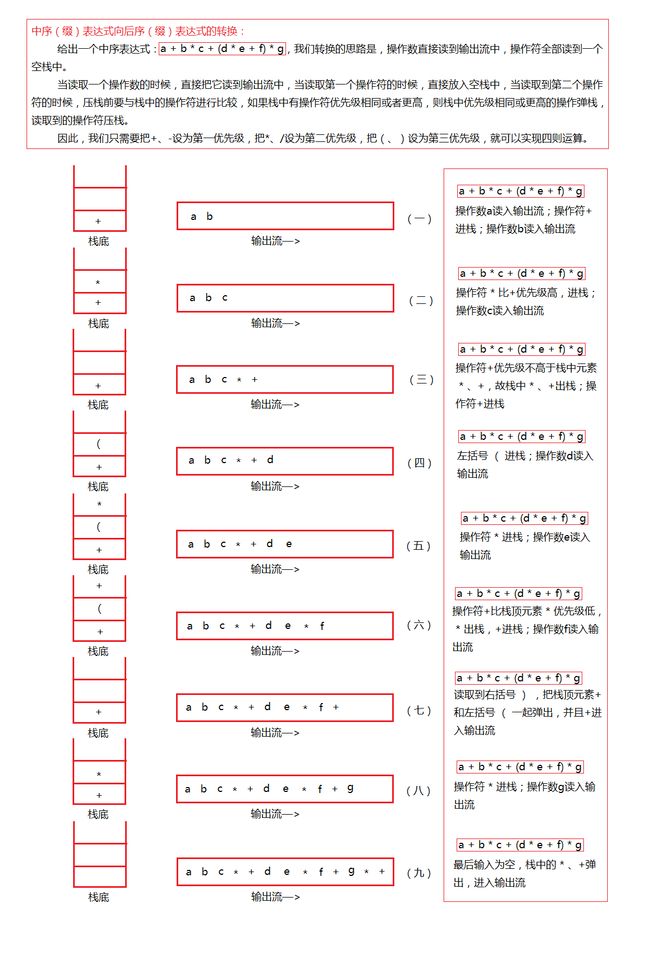【数据结构与算法分析】二叉查找树与AVL树
二叉树与普通树的区别在于二叉树的每个节点最多只能有两个儿子,节点就是有所存储的元素信息加上对其他节点(左、右子树)的引用组成的结构。表达式树就是二叉树一个很好地实现,如下图
表达式树可以由后序表达式转化而来,下图就实现了这个想法
而后序表达式又可以通过中序表达式转化而来,据悉转化过程见下图
查找树ADT——二叉查找树的实现细节
使二叉树成为二叉查找树的性质是,对于树中的每个节点X,它的左子树中所有项的值小于X中项的值,而它的右子树中所有项的值大于X中的项。下面的代码是二叉查找树节点类实现,代码如下
/*
*
*
*BinaryNode:二叉查找树的节点类
*
*
**/
private static class BinaryNode {
AnyType element;
BinaryNode left;
BinaryNode right;
// 构造器
BinaryNode (AnyType theElement) {
this (theElement, null, null);
}
BinaryNode(AnyType theElement, BinaryNode lt,
BinaryNode rt) {
element = theElement;
left = lt;
right = rt;
}
}
/*
*
*
*二叉查找树架构
*
*
**/
public class BinarySearchTree> {
private static class BinaryNode {
...
}
private BinaryNode root;
public BinarySearchTree() {
root = null;
}
public void makeEmpty() {
root = null;
}
public boolean isEmpty() {
return root == null;
}
public boolean contains (AnyType x) {
return contains(x, root);
}
private AnyType findMin() {
if (isEmpty())
throw new UnderflowException();
return findMin(root).element;
}
public AnyType findMax() {
if (isEmpty()) throw new UnderflowException();
return findMax(root).element;
}
public void insert(AnyType x) {
root = insert(x, root);
}
public void remove(AnyType x) {
root = remove(x, root);
}
public void printTree() {
...
}
private boolean contains(AnyType x, BinaryNode t) {
...
}
private BinaryNode findMin(BinaryNode t) {
...
}
private BinaryNode findMax(BinaryNode t) {
...
}
private BinaryNode insert(AnyType x, BinaryNode t) {
...
}
private BinaryNode remove(AnyType x, BinaryNode t) {
...
}
private void printTree(BinaryNode t) {
...
}
}
从上面我们也能看出二叉查找树提供了insert()、remove()、findMin()、findMax()、contains()、printTree()等方法我们接下来看看二叉查找树为的这些功能是怎样实现的。
/*
*
*
* contains()方法实现
*
*
**/
private boolean contains(AnyType x, BinaryNode t) {
if (t == null ) {
return false;
}
int compareResult = x.compareTo(t.element);
if (compareResult < 0) {
return contains(x, t.left);
} else if (compareResult > 0) {
return contains(x, t.right);
} else {
return true; //Match
}
}
/*
*
*
* findMin() 和findMax()方法实现
*
*
**/
private BinaryNode findMin(BinaryNode t) {
if (t == null) {
return null;
} else if (t.left == null) {
return t;
}
return findMin(t.left);
}
private BinaryNode findMax(BinaryNode t) {
if (t != null) {
while (t.right != null) {
t = t.right;
}
}
return t;
}
/*
*
*
* insert()方法实现
*
*
**/
private BinaryNode insert(AnyType x, BinaryNode t) {
if (t == null) {
return new BinaryNode(x, null, null);
}
int compareResult = x.compareTo(t.element);
if (compareResult <0) {
t.left = insert(x, t.left);
} else if (compareResult > 0) {
t.right = insert(x, t.right);
} else {
; //Duplicate, do nothing
}
return t;
}
/*
*
*
* remove()方法实现
*
*
**/
private BinaryNode remove(AnyType x, BinaryNode t) {
if (t == null) {
return t; //item not found, do nothing
}
int compareResult = x.compareTo(t.element);
if (compareResult < 0) {
t.left = remove(x, t.left);
} else if (compareResult > 0) {
t.right = remove(x, t.right);
} else if (t.left != null && t.right != null) {
t.element = findMin(t.right).element;
t.right = remove(t.element, t.right);
} else {
t = (t.left != null) ? t.left : t.right;
}
return t;
}


